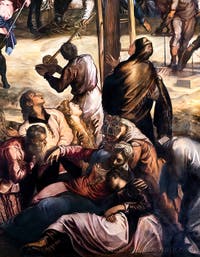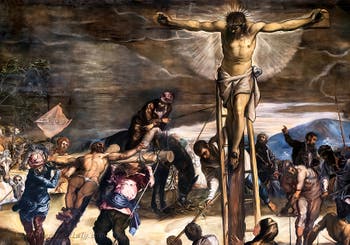Museums Doge's Palace | Guggenheim | Correr | Pesaro | Rezzonico | Murano | Accademia | Oriental | Ca d'Oro | Archeological | Querini | Bovolo | Pisani | Fortuny | Rocco | Lace | Marciana | Grassi | Dogana
San Rocco History Art | Location | Opening Hours Tickets | Authorizations
History Art Scuola | Rivalries | Crucifixion | Pilate Ecce Homo Calvary | Official Painter | Snake | Moses Manna | Sin Isaac Jacob | Adoration Temptation Breads | Probatic Pool Last Supper | Olive Garden Resurrection | Pianta | Annunciation Adoration Flight | Innocents Circumcision
“The Crucifixion” by Tintoretto at the Scuola Grande di San Rocco
Oil on Canvas (536 x 1224 cm) 1565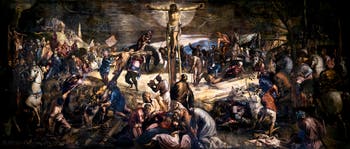
Crucifixon In 1565 Tintoretto painted the immense Crucifixion: 5 metres high and 12 metres wide!
The Crucifixion is an extraordinary work that takes up the entire wall opposite the entrance to the Albergo, exactly where Titian had proposed putting one of his paintings!
The haloed body of the crucified Christ stands alone in the middle of a low, dark sky, completely dominating the horizontal scene unfolding around him.
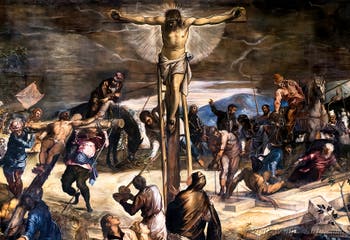
Crucifixon His head is bowed towards the grieving group at the foot of his cross: a young man and two women raise their heads and stare intently at him, helpless and full of love for the one they are accompanying to his last breath, while the others surround the Virgin Mary to comfort her.
They are very much alone in the midst of people who are completely indifferent to their suffering and very busy with their respective tasks.
One of them is dipping a sponge into a container of vinegar handed to him by another man, while to their right, two soldiers are playing dice and another is actively digging the hole where the thief's cross will be planted, as he lets himself be tied up by three other men.
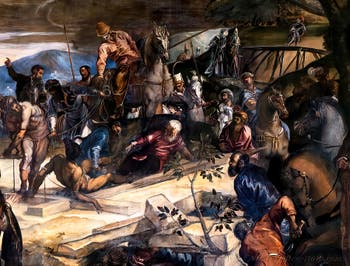
Tintoretto in the Crucifixon The bearded figure dressed in blue, leaning on the low wall just above the man digging, is the Tintoretto himself, who is watching it all very carefully.
On the left, those pulling on one side and pushing on the other to straighten the cross where the first thief is already tied up, his face turned towards Christ.
A whole crowd on foot and on horseback is watching the spectacle, surrounding the groups of men busy around the two thieves. In the foreground and to the left of the painting, on a white steed, a rider in armour points at Christ, while the others look at the tortured men with varying degrees of curiosity.
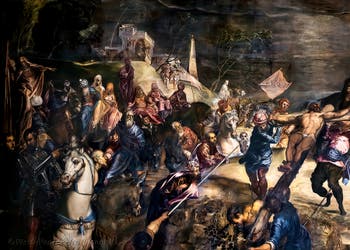
The Crucifixon The other riders quietly observe events, ready to turn bridle as soon as the job is done, leaving the three condemned to their agony...
This is the moment when the barbarian force encircles its victims with all its weight, leaving them no way out. Blind incomprehension and indifference or despair and a thirst for justice on earth, love and hope for those who raise their heads and turn towards the light.
This work would be studied very closely by many painters, notably the Flemish painters Rubens and Van Dyck.
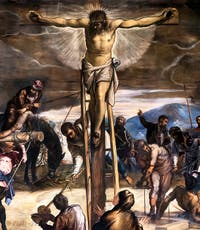
The Crucifixon And the Frenchman Maurice Barrès in The Death of Venice will admire
“the titan Tintoretto, author of this crucifixion at the Scuola San Rocco, whose innumerable characters, so furious with life, I marvel that could fit in a brain at the same time”
Théophile Gautier called Le Tintoretto a “terrible slaughterer of work”. Here's how he describes The Crucifixion, which he considers
“the masterpiece of this artist so fertile and uneven, who goes from the sublime to the detestable with prodigious ease”:Théophile Gautier - Italia 1855
“This immense painting represents in great detail the whole bloody drama of Calvary. It alone occupies the back of a large room.
The Crucifixon The sky, painted no doubt with the blue Egyptian ash that played such evil tricks on the artists of that time, has false and dodgy tones that are unpleasant to the eye, which it was not supposed to offer before the charring of this deceptive colour, which so strangely blackened the backgrounds of Paul Veronese's Pilgrims to Emmaus; but this imperfection is soon forgotten, so victoriously do the groups in the foreground take hold of the viewer after a few minutes of contemplation.
The holy women form the most profoundly despairing trio that human sorrow could ever dream of; one of them, completely covered in her cloak, lies on the ground and sobs in a desolate prostration of the most pathetic effect.
A negro, to erect the cross of one of the thieves, stands on tiptoe, with a contorted and strapped movement that lacks naturalness; but it is painted, like the rest of the picture, with a brush so vehement and furious, that one cannot help admiring it.
The Crucifixon Never did Rubens, never did Rembrandt, never did Géricault, never did Delacroix, in their most feverish and turbulent sketches, arrive at this outburst, this rage, and this ferocity.
This time, Tintoretto has fully justified his Robusti name; the vigour can go no further; this is violent, exaggerated, melodramatic, but clothed in a supreme quality: strength.”
The Crucifixion was an immediate success
After paying 250 ducats for it, the Confraternity immediately asked Tintoretto to complete the decoration of the Albergo with scenes from the Passion of Christ.And in 1582 (during Tintoretto's lifetime), Annibale Carracci made an engraving of it for the Cardinal de Medici.
History Art Scuola | Rivalries | Crucifixion | Pilate Ecce Homo Calvary | Official Painter | Snake | Moses Manna | Sin Isaac Jacob | Adoration Temptation Breads | Probatic Pool Last Supper | Olive Garden Resurrection | Pianta | Annunciation Adoration Flight | Innocents Circumcision
San Rocco History Art | Location | Opening Hours Tickets | Authorizations
Museums Doge's Palace | Guggenheim | Correr | Pesaro | Rezzonico | Murano | Accademia | Oriental | Ca d'Oro | Archeological | Querini | Bovolo | Pisani | Fortuny | Rocco | Lace | Marciana | Grassi | Dogana
Back to Top of Page


